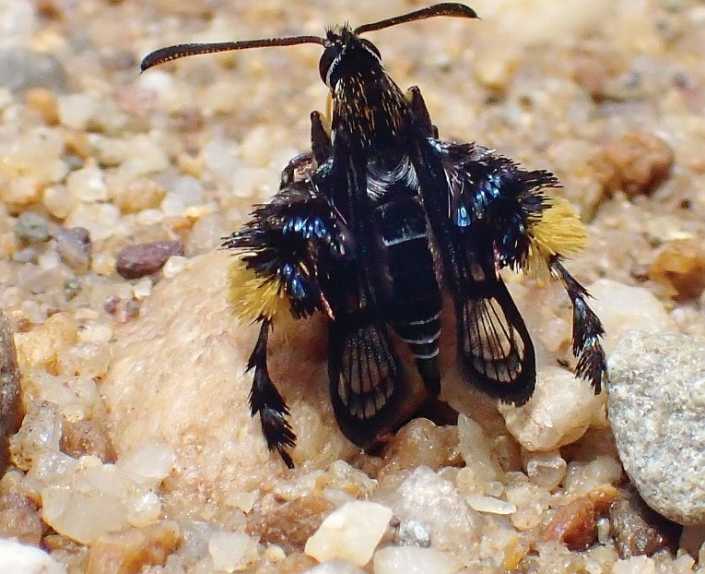© Marta Skowron Volponi
Mimicry is one of those evolutionary showpieces that has been used and researched for centuries. The Batesian classic theory has a mimic which is harmless and a model which often has a sting or some such offensive device for protection. The mimic has no defence but is protected anyway.
In this case, the Sessiid moths known as clearwings have a variety of stingless bees ( Tetragonilla spp.) and wasps to choose from. Each species model mimics a different hymenopteran, but often only a general phenotype. Our own mimic here is Heterosphecia pahangensis, a new species the researchers discovered! The moth was found only 7 times in 2 expeditions, meaning your Thai holiday is unlikely to allow a look at this particular clearwing, or indeed many others as the rainforests disappear. This novel individual mimics stingless bees. All the subjects of this video study were caught in horizontal flight as they performed mud-puddling behaviours near rivers in Malaysia and Thailand. The bees, bee mimics, wasps and wasp mimics such as Pyrophleps spp. all seemed to perform this puddling, probably as a physiological necessity.
The flight trajectories were digitised frame by frame to ensure the head was followed correctly. Hovering was flight at less than 0.1 m.s-1, and was excluded from analyses but presented in longest hovering time data because both bees and bee mimics were characterised by this behaviour. They flew in a meandering fashion, keeping their distance from and much slower than the rapid and direct-flying wasps and their mimics.
Defying the definitions, as many models do, the relevant Tetragonilla bees here have no sting, but like other relatives, behave exactly as if they have, with a bite often given to add emphasis! Such behaviour is typical of the mimics, borrowing a trick from them. They have to cope with that load of mimicry, presumably by being predated more by savvy insectivores! A point of information is that no male wasp or bee can sting us, but we avoid them as we do the many mimics.
In conclusion, the researchers from the University of Gdansk (Poland) Macquarie (Australia) and UC Berkeley (US), as well as the Clearwing Foundation for Biodiversity in Warsaw, had to cope with a rarity of specimens. Most of these species are never seen, except occasionally as individuals. Hence the stake-out of muddy puddles. The bird, spider and beetle predators observed possibly restrict the numbers, but human activity and loss of rainforest is likely to restrict these animals massively. The predators however seem to have created generalist mimics, whose flight pattern more resembles their models than their actual phenotype or even colour. The wasps particularly can hardly be seen by predators or ourselves, meaning both clearwings and wasps cannot be distinguished clearly as they are being caught (if they ever are caught on the wing!
The lead author (and photographer) in the Royal Society Biology Letters is Marta Skowron Volponi of Uniwersytet Gdanski titling the paper, Moving like a model: mimicry of hymenopteran flight trajectories by clearwing moths of Southeast Asian rainforests.
We have to also congratulate all of the workers for such a dedicated and productive piece of original research.










